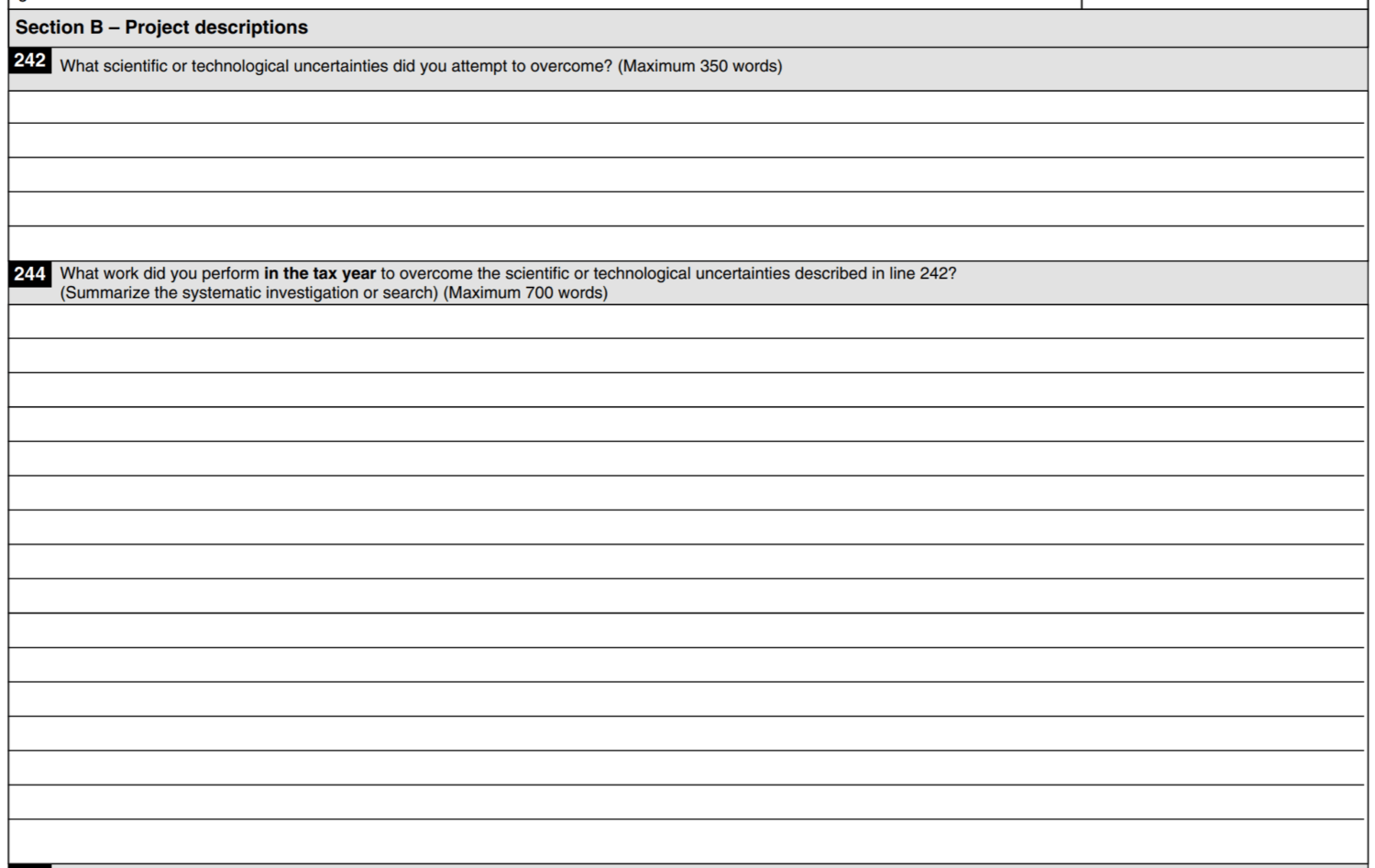Work Performed: Making Sure You Include Enough Detail (Line 244)
Attention: Policies May Have Been Updated *** Some of the policies referenced were updated 2021-08-13. We are working to update this article and others. *** |

When preparing a T661 for submission to the Canada Revenue Agency as part of your Scientific Research & Experimental Development (SR&ED) investment tax credit application, Line 244 is the largest part of what is colloquially known as the “technical narrative”. In this section, you are asked “What work did you perform in the tax year to overcome the scientific or technological uncertainties described in line 242?” What many people don’t know is that if you only answer this question you will likely be selected for review. In this post, we discuss what actually needs to be included in Line 244, what to leave out, and why.
Line 244: The Basics
The CRA allots 700 words in Line 244 to succinctly summarize your experiments or analysis in a chronological manner.
Line 244 is based off of Line 242. You record your strategic responses to the uncertainties that led you to do the SR&ED. In other words, Line 242 was the objective you were trying to achieve. Line 244 is how you achieved it.
The T4088 – Guide to FormT661 asks that you include the following:
In responding to this question, describe, in a clear and concise manner, how you attempted to overcome the scientific or technological uncertainties that you identified at line 242.
Describe the work done in chronological order. In doing so, clearly demonstrate the systematic nature of the investigation or search. This includes describing;
-
- the hypotheses designed to reduce or eliminate the uncertainties;
- experiments and/or analysis conducted to test the hypotheses;
- the results obtained; and,
- the conclusions.
If this is a continuation of a previously claimed project, it is important that you focus on the work carried out during the tax year for which you are making the claim.
If all or part of the work was performed on your behalf by contractors, include that work in your description and identify that the work was performed by contractors. 1
You’ll notice that this is much more than just describing your work. You are asked to provide details on your hypotheses, experiments testing said hypotheses, pursuant results, and conclusions drawn from results.
So, what should you include & what should you exclude?
What to Include
A sufficient Line 244 will include:
- The hypothesis made when you began your SR&ED. This hypothesis should be “consistent with known facts.”2 It draws from a prior knowledge base. The hypothesis is “a starting point for further investigation” which will be supported or negated.3
- The “experiments and/or analysis” performed to “test the hypotheses”.4 These “structured and organized tests and studies” should be recounted in a way that shows connections between the experiments, explains their results and lists any additional tests.5 These tests must be experimental as the “method of finding the solution to the problem” was unknown.6 Experiments and analyses will be iterative processes as “new uncertainties are recognized”.7 Therefore, quantifiable details and uncertainties that arise during experimentation are important to include.
- The recorded results of your experiments or analysis.
- The conclusions, drawn from your results, should connect back to the hypothesis. Whether your hypothesis was confirmed or negated is stated clearly.
What to Exclude
- Development work is not SR&ED. Work revolving around the “commercial production of a new or improved material, device,” product, or process is not technological advancement.8 New-and-improved capabilities of a product don’t enrich the existing knowledge base and shouldn’t be claimed as SR&ED.
- Trouble-shooting to solve “a functional problem rather than to address a problem in the underlying technology” is not experiment or analysis.9 It is not applicable, because of the lack of intention to develop a broader understanding or technological advancement.
- Information regarding marketability shouldn’t be included. “Doubt about the business or commercial success of the material, device, product, or process” is not technological uncertainty.10
- Mentions of project “complexity” as uncertainty shouldn’t appear in Line 244. A complex project or technology does not inherently present uncertainty. Simply because a project is complicated “does not justify that the work performed in that project falls within the definition of SR&ED.”11
Other Tips
When writing this section, it’s important not to describe the work as being straightforward or routine. Common errors include descriptions of the final results as opposed to the process to obtain the final results. If it sounds easy, it’s very difficult to justify your costs.
Summary
Line 244 seems difficult: it does not have to be. Remember to include your hypothesis, experiments/analysis, results, and conclusions. Detail any uncertainties that arose before or during the experimental development. Leave out any commercial language, or mentions of trouble-shooting and “complexity”. Focus on your experiment or analysis, and you’ll have a winning Line 244!